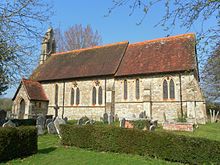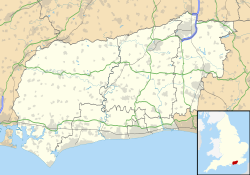St Leodegar's Church, Hunston
| St Leodegar's Church | |
|---|---|

The church from the southwest
|
|
|
Location of the church within West Sussex
|
|
| 50°48′23″N 0°46′27″W / 50.8065°N 0.7742°WCoordinates: 50°48′23″N 0°46′27″W / 50.8065°N 0.7742°W | |
| Location | Church Lane, Hunston, West Sussex |
| Country | United Kingdom |
| Denomination | Anglican |
| History | |
| Founded | c. 12th century |
| Dedication | Leodegar |
| Consecrated | 22 October 1885 |
| Events | 25 March 1885: original ruined church demolished |
| Architecture | |
| Status | Parish church |
| Functional status | Active |
| Architect(s) | Arthur Blomfield |
| Style | Early English Gothic Revival |
| Groundbreaking | 1885 (present building) |
| Completed | 1885 (present building) |
| Construction cost | £4,500 (£438,000 in 2017)) |
| Administration | |
| Parish | Hunston |
| Deanery | Rural Deanery of Chichester |
| Archdeaconry | Archdeaconry of Chichester |
| Diocese | Diocese of Chichester |
| Clergy | |
| Rector | Rev. James Russell |
| Curate(s) | Rev. Neil Coleman |
St Leodegar's Church is the Anglican parish church of Hunston, a hamlet in the Chichester district of West Sussex, England. The dedication—rare in England and unique in Sussex—has also been spelt St Ledger historically. A ruinous church dating from the 12th century was dismantled and rebuilt by prolific ecclesiastical architect Arthur Blomfield in 1885, but some old features were retained. The building, an Early English Gothic Revival structure of stone, was criticised by architectural historian Nikolaus Pevsner but was built on a "generous" budget and has some elaborate structural features such as a double belfry.
Hunston is a large, spread-out village on the coastal plain south of the city of Chichester. "Good wheat-growing land" surrounds the residential development in the 1,013-acre (410 ha) parish. A church has served the village since the 12th century or earlier: in 1105 it was granted by Robert de Haye to Lessay Abbey in Normandy. Its dedication to St Leodegar, the 7th-century bishop of Autun, may derive from this French connection. Bishop Leodegar (c. 616–678), sometimes anglicised to Leger or Latinised as Leodegarius, was martyred by having his tongue and eyes pulled out and being beheaded.Boxgrove Priory, a few miles away and also a possession of Lessay Abbey, administered the church until the Reformation in the 16th century.
The old church was well documented in the 18th and 19th centuries. Its rector between 1719 and 1759, Charles Covert, did work on the chancel during his incumbency. The antiquarian Sir William Burrell, 2nd Baronet, who visited most of Sussex's parish churches during the 18th century, recorded St Leodegar's Church as having a chancel and a nave with a south aisle. It was pictured and described again 16 years later in The Gentleman's Magazine: there was a flat-arched entrance in the west wall and an older (apparently 12th-century) south door with Norman-style chevron moulding, a continuous roof over the nave and south aisle, a three-bay pointed-arched round-columned arcade separating the aisle and nave, and lancet windows throughout. The church was said to be "in so decayed a state that its utter ruin seems unavoidable before long". Similar features were depicted in sketches by other artists in the 19th century, including one dated c. 1851 by Richard Henry Nibbs in which the nave and chancel were clearly in ruinous condition. His accompanying notes bore this out. A survey of Sussex churches by John Mason Neale and Benjamin Webb in 1841 noted that there were wall murals inside in the form of painted Biblical verses.
...
Wikipedia

